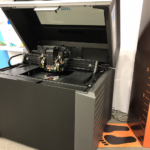

I find soft robotics to be utterly fascinating. While the technology has been around for a while, it’s recently begun to really advance in unprecedented ways – thanks in part to 3D printing. The ability of 3D printing has enabled soft, polymer-based materials to be developed and used in ways that were never possible before, and that’s translated into some amazing advancements for soft robotics – like the world’s first fully autonomous soft-bodied robot, for example.
Now a team of students at Delft University of Technology (TU Delft) have developed a new method for 3D printing soft robotics – one that not only opens up new applications, but does it cheaply.
The method is called UltiCast, and the team developed it by rebuilding an Ultimaker 3D printer (it seems like a lot of scientists have been doing that lately!) and adding a component that involves two syringes, each filled with a different silicone material.
“It is a combination of moulding and 3D printing,” said Max Nobel, a student in TU Delft’s Industrial Design Engineering program. “The machine makes a plastic shell, which is filled with 2-components silicones at the same time.”
The shell is made from PVA, or polyvinyl alcohol, a polymer that dissolves in water, leaving a cured silicone object behind. The technique allows for the creation of complex shapes with a kind of surface quality that most standard FDM printers are incapable of achieving. UltiCasting makes it possible to print a soft actuator within a mold, much more quickly – and with more design freedom – than typical casting methods.
The method can also be used to mix hard and soft materials in one print; for example, one experiment involved the printing of a hard skeleton inside soft silicone. UltiCasting also allows for a precise level of customization.

“You get a lot of freedom to personalise the behaviour of robots with geometry and materials,” said Rob Scharff, a PhD student in soft robotics. “You make sure that the robot behaves exactly as you want to…You can use various materials during printing. The results are much more complex materials.”
Last year, Scharff created a soft robotic hand that responds to human touch and grip as part of a research project. His next goal, he said, was to develop a pair of 3D printed gloves that would help stroke victims learn to grip objects again, and he and the UltiCasting team remain focused on the potential medical applications of their technology. They developed a glove with soft robotic actuators that help the movement of the fingers – a technology that could benefit people with arthritis or other conditions that limit hand function, as well as aid in rehabilitation from injury.
The 3D printed glove is just a prototype, and the team isn’t looking to create a finished product right now, but to demonstrate the possibilities their technology offers, especially for the medical field.
“3D printing offers a variety of applications, being soft robotics one of them,” said coordinator Jouke Verlinden. “It allows you to make things that are impossible with traditional robotics. Soft robotics is a research theme in which we invest a lot.”
According to Scharff, the system the students developed cost about $3,000 – much less than other multimaterial 3D printing systems, which can cost up to $300,000. The team presented their project at a recent science fair that TU Delft held for its Advanced Prototyping minors. (Go check out some of the other projects presented at the fair – there is some really fascinating work being done with 3D printing at this school!) You can read more about the UltiCast project and the students behind it here. Check out a time-lapse video of the UltiCasting process below:
Discuss in the UtiliCasting forum at 3DPB.com.
[Source: RoboValley / Images: TU Delft UltiCasting team]
If you're looking to get architectural 3D animation in the USA, our service provides an exceptional way to bring your architectural concepts to life through dynamic, immersive visuals. Through our platform, you can easily request high-quality 3D animations that showcase your designs in motion, offering a detailed view of your project from multiple angles and perspectives. Whether it's for a real estate development, a commercial building, or an urban planning project, our expert team ensures that every detail is captured in a visually compelling animation.
Through our website, you can seamlessly get architectural 3D animation tailored to your project’s specific needs. With our help, you can offer potential clients or investors an engaging experience that goes beyond static images. By integrating CGI animations with real-world settings, lighting, and textures, our team creates a lifelike experience that allows your audience to interact with your project as though it were already built. This service is perfect for presenting complex designs in a clear, visually attractive way that stands out in the competitive architectural market.




